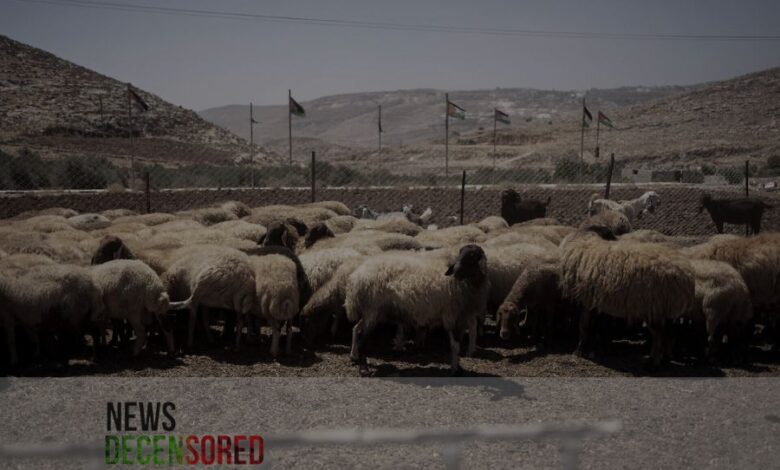Behind the dust of war… West Bank settlers are displacing its farmers and shepherds

Since Israel began its war on Gaza following the October 7, 2023 attack on the settlements surrounding Gaza, Israeli settlers’ attacks on Palestinians have become so violent that Palestinian farmers were forced to leave the land they inherited from their fathers and grandfathers.
More than 1,200 Palestinians across the occupied West Bank have been forced from their homes since the fighting began, according to human rights groups and the United Nations.
Data collected by activists and verified using satellite images by the island’s verification unit, Sanad, shows that between October 2023 and January 2024, settlers in the occupied West Bank built at least 15 outposts. settlement and 18 roads, which is illegal under Israeli and international law. In addition, settlers built hundreds of meters of barbed wire and double road barriers, further restricting the movement of Palestinians.
Dismantling
This hitherto unprecedented displacement has led to the disintegration of at least 15 Palestinian communities, with Israeli settlers rapidly expanding their presence. Experts say their goal is to reshape the demographics of the West Bank while breaking the backbone of the lands designated for a future Palestinian state.
“When there is a war, the settlers take advantage and try to establish as many outposts as possible,” said Mauricio Lapchick, an activist with Peace Now, an Israeli organization that documents settlement activities. Note that a similar increase in illegal settlement outposts was recorded during the years of the Second Intifada in the early first decade of this century.
Settlement outposts are usually temporary camps ranging in size from a few caravans to a few prefabricated buildings erected in rural Palestinian areas.
These outposts were built by members of the broader Israeli settlement movement, which seeks to impose an Israeli presence on the illegally occupied territories. The outpost builders are often motivated by an extremely hard-line ideology that demands that Jews fill all Palestinian lands and force the Palestinians to leave.
Like settlements, these outposts are considered illegal under international law. Although Israel considers them illegal, claiming that they were established without government approval, it nevertheless often retroactively approves them as settlements, and the army, for its part, connects the outposts and temporary caravans to water and electricity, and the settlers impose them as a fait accompli.
Connecting to electricity and water constitutes one of the most important stages of transforming these settlement outposts into permanent ones, when they become viable for settler families after initially being limited to the “hilltop youth” who carry out the initial takeover process, and then the state and army provide them with the necessities for survival and expansion.
Satellite images show settlement sites built in the first four months of the war spread across the occupied West Bank, indicating that Israeli settlers are becoming bolder and expanding their presence beyond areas close to the existing settlements.
Post-war
Roads are essential for establishing a presence in remote areas, and many of them have been built on private Palestinian property since October 7.
Dozens of roads not only represent a seizure of Palestinian land but have also become paths that Palestinian farmers and shepherds fear crossing because they will be exposed to settler attacks.
The satellite images documented below show dozens of new roads built after October 7 to connect outposts to other Israeli-controlled areas, such as farms or settlements.
Settlers force Palestinian residents off their lands in the occupied West Bank by violently intimidating them or by limiting their access to pastures by building outposts and roads around their communities, forcing them to move away in search of safety and livelihoods for their families.
This has been happening for decades but has expanded in scope and intensity since the beginning of the war, against the backdrop of an already record year of violence in the Palestinian territories.
In this regard, researcher Ahmed Haniti, who is interested in Bedouin communities in Palestine, says that pastoral communities are targeted by the occupation because they use large areas of Palestinian land for housing and grazing. He explained in a video recording broadcast by the Institute for Palestine Studies, saying, “In the last five years, attacks on Bedouin and herding communities by settlers and the army have increased. But after October 7, these attacks accelerated more and more, as the settlers were armed due to the state of emergency and war, and a number of them joined the military service and served.” In the Jordan Valley region, their attacks are now carried out in military clothing and sometimes in civilian clothing, as in the government’s view they are defending the biblical Land of Israel.”
It is noteworthy that the United Nations recorded, in the first ten months of 2023, no less than 1,038 violent incidents by settlers, at a rate of 3 attacks per day, and the same number has nearly doubled 3 times since October.




